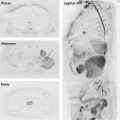Functional MR imaging methods make possible the quantification of dynamic physiologic processes that occur in the brain. Moreover, the use of these advanced imaging techniques in the setting of oncologic treatment of the brain is widely accepted and has found worldwide routine clinical use.
Key points
- •
A multiparametric MR imaging approach can better guide lesion biopsy to the place of higher perfusion, lower ADC, and increased levels of choline, representing the most aggressive areas within a neoplasm.
- •
Multiparametric MRI can also predict the histopathologic diagnosis of the lesion; some specific neoplasms have particular MR imaging characteristics, for example lymphoma, which presents low ADC values, low perfusion, and high choline associated with lipids and lactate peaks on MRS.
- •
In general, anaplastic neoplasms have higher perfusion and permeability, higher choline levels, and lower ADC values than low-grade gliomas.
- •
Tumor treatment response can be assessed by changes depicted in the advanced MR imaging sequences in the sequential examinations performed before, during, and after the therapy.
- •
Overall survival is worse if a tumor presents high choline, lipids and lactate, restricted diffusion, and high perfusion (rCBV >1.75).
Stay updated, free articles. Join our Telegram channel

Full access? Get Clinical Tree




